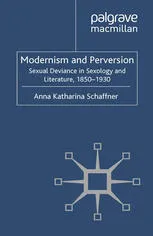Modernism and Perversion: Sexual Deviance in Sexology and Literature, 1850–1930
4.5
بر اساس نظر کاربران

شما میتونید سوالاتتون در باره کتاب رو از هوش مصنوعیش بعد از ورود بپرسید
هر دانلود یا پرسش از هوش مصنوعی 2 امتیاز لازم دارد، برای بدست آوردن امتیاز رایگان، به صفحه ی راهنمای امتیازات سر بزنید و یک سری کار ارزشمند انجام بدینمعرفی کتاب: Modernism and Perversion: Sexual Deviance in Sexology and Literature, 1850–1930
کتاب «Modernism and Perversion: Sexual Deviance in Sexology and Literature, 1850–1930» به قلم آنا کاترینا شافنر یک اثر علمی بینارشتهای است که به بررسی رابطه پیچیده بین گفتمانهای سکشوالیتی در دانش جنسی (Sexology) و ادبیات مدرنیستی در دورهای میان سالهای ۱۸۵۰ تا ۱۹۳۰ میپردازد. این اثر به طور جامع به شکلی که گفتمانهای علمی درباره «انحراف جنسی» در شکلگیری تخیل ادبی مدرنیسم تأثیرگذار بودهاند، نور میافکند.
خلاصهای جامع از کتاب
این کتاب کاوشی هوشمندانه در خطوط تلاقی بین دنیای علم و دنیای هنر است. هدف آن بررسی این نکته است که چگونه مقولات علمی نوظهور در خصوص انحرافات جنسی به طرزی عمیق و پیچیده به متون ادبی مدرنیستها نفوذ کرده و چگونه نویسندگان مهم این دوره، ایدههای گرفتهشده از Sexology را در زمینههای خلاقیت ادبی خود به کار بستهاند.
شافنر در این کتاب تحلیل میکند که چگونه نظریههای ابتدایی دانش جنسی درباره سکشوالیته انسانی، مانند مفهوم «انحراف جنسی»، به عنوان ابزارهایی برای نویسندگان مدرنیست به کار رفته تا بتوانند به چالش کشیدن هنجارهای اجتماعی و هنری زمان خود بپردازند. نویسندگان و متفکرانی مانند فروید، کرافت-ابینگ، و ماگنوس هرشفلد به همراه بسیاری دیگر در این تحلیل جایگاه ویژهای دارند.
این کتاب با تحلیل مقالات علمی و متون ادبی، فرآیندی را بازنمایی میکند که در آن دانش سکشوالیتی تبدیل به بخشی از ایدئولوژی فرهنگی میشود و مدرنیسم را به لحاظ زیباییشناسی تغییر میدهد.
نکات کلیدی
- اتصال میان دو گفتمان عمده مدرن: علم و هنر.
- نقش Sexology در ایجاد مفاهیم جدید از سکشوالیته و انحراف جنسی.
- تحلیل دقیق نقش نویسندگان مدرنیست در بازنمایی انحراف جنسی به عنوان تماتیک هنری.
- بررسی تأثیر نظریات علمی درباره سکشوالیته بر ادبیات و هنر مدرن.
نقلقولهای معروف از کتاب
“Modernist literature did not merely mirror the medico-scientific discourses on sexual deviance—it actively engaged with, critiqued, and incorporated them into its own aesthetic and ideological frameworks.”
“The interplay between sexology and modernism evidences the porous boundaries between scientific and literary discourses in the late nineteenth and early twentieth centuries.”
چرا این کتاب مهم است
کتاب «Modernism and Perversion» اثری است که برای تمامی علاقهمندان به نقد ادبی، تاریخ فرهنگی، و نظریههای سکشوالیته بسیار ارزشمند است. این کتاب نگاهی جدید به اشتراکات و تعارضات میان دانش علمی و تخیل هنری در عصر مدرنیسم دارد و از اهمیت ادبی و تاریخی بالایی برخوردار است.
- درک عمیقتر از تأثیر نظریات روانتحلیلگری و Sexology بر مفاهیم هنری.
- شناخت بهتر از گفتمانهای مدرنیستی و تغییر در شکلگیری هویت جنسی.
- بررسی چالشهای میان علم و هنر در دورهای پر از تغییرات فکری.
Modernism and Perversion: Sexual Deviance in Sexology and Literature, 1850–1930
Modernism and Perversion: Sexual Deviance in Sexology and Literature, 1850–1930 by Anna Katharina Schaffner is a seminal work that explores the intricate connections between sexology and literary modernism during a transformative period in cultural history. This book delves into how scientific discourses on sexual deviance influenced and, in turn, were shaped by the avant-garde literature of the late nineteenth and early twentieth centuries. It offers a profound analysis of the cultural anxieties and intellectual debates surrounding human sexuality, deviancy, and morality during an era characterized by radical shifts in societal norms.
Detailed Summary
The book analyzes the intersection of sexuality, science, and literature between 1850 and 1930, a period marked by profound cultural and intellectual change. Anna Katharina Schaffner examines how sexologists, such as Richard von Krafft-Ebing, Sigmund Freud, and Havelock Ellis, defined and categorized sexual deviance, including behaviors and identities that deviated from heteronormative standards. These early works in sexology laid the groundwork for understanding human sexuality, but they also reflected societal prejudices and regulatory mechanisms designed to control perceived moral transgressions.
Meanwhile, this era witnessed the emergence of modernist writers such as James Joyce, D.H. Lawrence, Virginia Woolf, and Marcel Proust, whose literary works often tackled themes of sexual identity and transgression in revolutionary ways. Schaffner argues that there was a dynamic exchange between the nascent field of sexology and avant-garde literature, whereby modernist writers both drew upon and challenged the parameters established by sexologists. These literary figures pushed boundaries not only in content but also in form, using experimental techniques to disrupt conventional narratives and explore the fragmented nature of human desire and identity.
The book thoroughly investigates how literary modernism questioned normative frameworks, using sexuality as a lens to explore broader societal taboos and cultural shifts. By scrutinizing texts that often provoked outrage and censorship, Schaffner unveils the complex ways art interacted with scientific theories to aid in understanding the fluid and multifaceted nature of human sexuality during this pivotal historical moment.
Key Takeaways
- Sexology in the late nineteenth and early twentieth centuries introduced critical frameworks for categorizing human sexuality, which were simultaneously rigid and open to questioning by cultural movements.
- Modernist literature engaged deeply with concepts of sexual deviance, challenging the dichotomy between normal and abnormal, and embracing the complexity of sexual identity and desire.
- The period of 1850–1930 reveals the reciprocal influence between scientific disciplines and artistic expression, underscoring how cultural products often shape and redefine intellectual paradigms.
- By analyzing both sexological texts and modernist works, the book provides a comprehensive view of how sexuality was conceptualized and represented during this transformative period.
- Artistic innovation and scientific inquiry often shared a common goal: the unveiling of suppressed truths about human existence and the interrogation of cultural norms.
Famous Quotes from the Book
"Both sexology and literature sought to uncover hidden truths about human sexuality, albeit through radically different methods—one analytical, the other imaginative."
"The destabilization of normative constructs in modernist literature offered a symbolic liberation from the rigid taxonomies imposed by early sexology."
"Sexual deviance, rather than being purely pathologized, became a site of artistic inquiry and a metaphor for exploring broader epistemological ruptures."
Why This Book Matters
Modernism and Perversion is not merely an academic text; it is an essential lens through which readers can better understand the profound cultural shifts that occurred from the Victorian era to the early twentieth century. By illuminating the symbiotic relationship between sexology and literary modernism, this book sheds light on how science and art mutually influenced one another during a time of significant change in attitudes toward sexuality.
It also holds contemporary relevance by examining how cultural narratives around sexual identity and morality evolve. In an era that continues to grapple with questions of inclusivity, representation, and the fluidity of human sexuality, Schaffner’s work provides historical context for ongoing debates. The book serves as a bridge between the past and the present, urging readers to investigate how intellectual and artistic movements shape societal perceptions of human desire and identity.
Whether you’re a scholar of modernist literature, a student of sexology’s history, or a curious reader interested in the interplay between science and art, Modernism and Perversion offers invaluable insights into a fascinating era. Its interdisciplinary approach ensures that it appeals to a wide range of audiences, fostering deeper understanding of the forces that shaped modern sexual discourse.
دانلود رایگان مستقیم
شما میتونید سوالاتتون در باره کتاب رو از هوش مصنوعیش بعد از ورود بپرسید
دسترسی به کتابها از طریق پلتفرمهای قانونی و کتابخانههای عمومی نه تنها از حقوق نویسندگان و ناشران حمایت میکند، بلکه به پایداری فرهنگ کتابخوانی نیز کمک میرساند. پیش از دانلود، لحظهای به بررسی این گزینهها فکر کنید.
این کتاب رو در پلتفرم های دیگه ببینید
WorldCat به شما کمک میکنه تا کتاب ها رو در کتابخانه های سراسر دنیا پیدا کنید
امتیازها، نظرات تخصصی و صحبت ها درباره کتاب را در Goodreads ببینید
کتابهای کمیاب یا دست دوم را در AbeBooks پیدا کنید و بخرید
1187
بازدید4.5
امتیاز50
نظر98%
رضایتنظرات:
4.5
بر اساس 0 نظر کاربران
"کیفیت چاپ عالی بود، خیلی راضیام"
Questions & Answers
Ask questions about this book or help others by answering
No questions yet. Be the first to ask!


